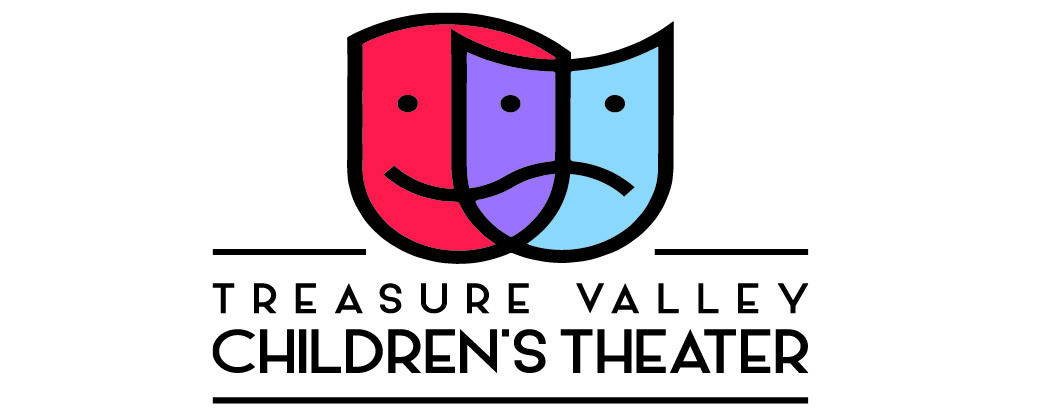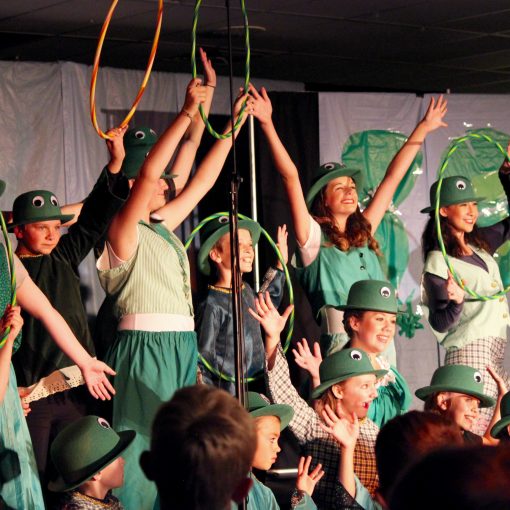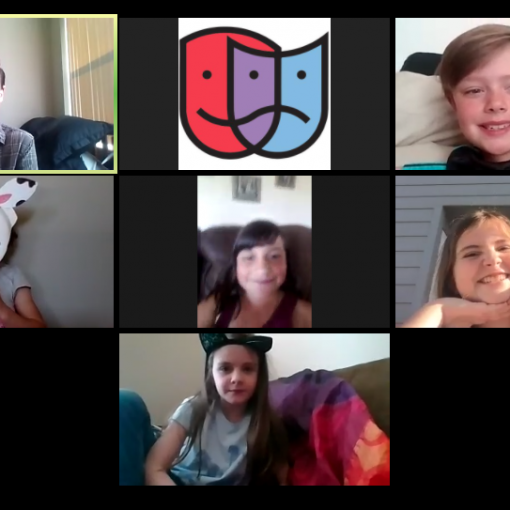
(originally posted April, 2014)
I was recently asked to speak at The College of Southern Idaho (my Alma mater, class of 1996) regarding my work in the arts. This opportunity provided a period of reflection as well as some time too research the impact of community-based arts programs. I’ve included an excerpt from my speech in this blog. It provides a strong case for supporting community-based arts.
Why do we invest our time and energy into creating community based art, and why do others support that investment with one of their own? Why create community-based art when we could easily sit in front of our giant TV’s and watch Netflix until we’re entertained to death?
The answer might seem obvious too many, but I’ll be honest, it’s taken many years of introspection and self journey to come to the realization that if I want to change the world, I have to start within my own community.
I believe community-based arts programs can change the world.
“Community-Based Art” or “Community Engaged Art” refers to artistic activity based and created in a community setting. Works from this genre can be of any media and is characterized by interaction or dialogue with the community.
If you’ll permit me, I’d like to introduce you to some rather unfortunate facts. It may seem that I’m steering us off course, but I promise to bring us back to the claim, community-based arts can change the world.
I want to talk about teen pregnancy for a minute, and start with some good news! According to the National Center for Health Statistics at the Centers for Disease Control and Prevention, the birth rate among young women ages 15 to 19 fell 6 percent in 2012, the lowest rate in the 73 years the government has been collecting the data. That’s excellent news – but what about the children born to teen mothers…
Did you know children of teen parents are 50% more likely to repeat a grade and less likely to finish high school than children of older parents? Children of teen mothers are more likely to experience a teen pregnancy themselves, homelessness, juvenile delinquency and incarceration. And children born to teen mothers are more likely to be abused, abandoned or neglected.
The cards are stacked against these kids before they have even opened their eyes.
Teen girls who get pregnant are also more likely to be single parents. 90% of single-parent families are headed by females. These families have the highest rate of poverty across all demographic groups. Approximately 60% of US children living in mother-only families are impoverished.
Now, there is a lot of debate about single-parent families, and it’s not my intent to disparage these hard-working mothers and fathers. I think you’ll understand why in a minute. But the research indicates that children from single-parent families are more likely to experience less healthy lives, are more likely to drop out of school, bear children out of wedlock, have trouble keeping jobs, and suffer other psychological and social consequences.
What does this data have to do with the topic today? Actually, it has everything to do with it for me, personally.
In 1975 I was born in Boise to a 19 year-old girl who had barely finished high school. A bit of a free spirit, you might say – the fact that my name is ‘Autumn’ should give you a good indication of the hippie my mother was. The biological father in the situation was a bit of a mystery… so my mother found herself a single parent. She was couch surfing at the time and living in and out of her Volkswagon. She was homeless. In fact, we were homeless for a good portion of my infant life. Sometime around 1979, as I approached school age years, my mother decided it was time to settle down. She moved us to Twin Falls to be closer to her family in Hagerman and to find work.
Fast forward to 1984, my mom was working for one of the local radio stations as a DJ and had a couple of tickets to see a theater production called “SNOOPY” being performed by a local group, Junior Musical Playhouse, or JuMP Company. It starred local youth. It was performed in an old church in downtown Twin Falls.
It was the first play I remember seeing and it changed my life.
My mother really, REALLY did NOT want me to study theater. Theater can be a harsh mistress. It can be incredibly devastating to ones self esteem, especially if they lack in confidence. And I did. I was painfully shy, exceptionally sensitive, and just pleading for people to accept me. My mother’s concerns were valid.
But, there was no stopping me. After seeing “SNOOPY” I auditioned for and landed the lead in our school play at Harrison Elementary – I was 11 at the time. I followed that experience with JuMP Company’s fall Musical Theatre Showcase where I recited “The Crocodile’s Toothache” by Shel Silverstein, and from 1986 to 1996 I performed in plays all around Twin Falls, in school productions, with JuMP Co., the Dilettantes, Drama Camps – wherever I could find a stage, I was there.
But the performance opportunities are not really the heart of my story. I gained a lot of experience and confidence from these programs, but the people within these community-based arts organizations made the big impact. They had as much to do with raising me as my mother did. And they played a major role in altering my future.
Remember the statistics for children born to teen, single mothers? Layer on top of the poverty challenges, a brief but impactful four years with an alcoholic step father – and the odds were really stacked against me. Any social worker would tell you that I should have failed school, gotten pregnant, taken drugs, become an alcoholic, and painted the picture of a truly unfortunate outcome.
If it were not for the theater experiences and the theater family that embraced me – the rides too and from rehearsal, the anonymous donors who paid my participation fees when my mother couldn’t, the directors and teachers who spent extra time with me, and the countless friends. . . perhaps I would have fallen victim to the statistics without these interventions.
Or perhaps I’m just an anomaly. That the community-based arts groups had very little to do with my decision to go to college, too earn a Masters degree, too start a nonprofit organization, too live a happy life, to contribute to my community… perhaps…
Anyone who has worked in the arts and with youth in arts, you possess volumes of anecdotal evidence and stories regarding how that art experience changed lives. When young people are involved with the arts their life changes. Advocates for the arts often use photographs of smiling faces to document the experience.
But in a society that values measurement and data-driven analysis, photographs of smiling faces is not enough to prove a point. And the arts industry really needs to do a better job of quantifying outcomes. Funding for arts education programs in schools is being cut back or eliminated. Many arts organizations have had to make drastic reductions in hours, and offer fewer productions each season. Donations to nonprofit arts groups significantly decreased during the recession. And every year the National Endowment for the Arts funding is further threatened.
For decades, arts education research did little more than establish correlations between exposure to the arts and certain outcomes. Research that demonstrates a causal relationship had been virtually nonexistent.
However, from 1989-1999 seven teams of researchers examined a variety of arts education programs using diverse methodologies. They compiled their findings in report titled, “Champions of Change: The Impact of the Arts on Learning.” The report demonstrates significant evidence that draws causal parallels between outcomes from art based programs and student achievement. The findings were so relevant that the report continues to be cited in arts-research circles. I will do my best to summarize the key findings.
Analysis of the Department of Education’s database of 25,000 students demonstrated that students with high levels of arts participation outperform “arts-poor” students – students not engaged in arts programs. Since arts participation is highly correlated with socioeconomic status, which is the most significant predictor of academic performance, this outcome comes as little surprise.
The size and diversity of the database, however, permitted “Champions of Change” researchers to find statistical significance in comparisons. This closer look showed that high arts participation makes a more significant difference to students from low-income backgrounds than for high-income students. Researchers also found clear evidence that sustained involvement in particular art forms—music and theater—are highly correlated with success in mathematics and reading.
Learning in and through the arts can help “level the playing field” for youngsters from disadvantaged circumstances – it certainly made a difference for me.
Now, arts programs are not the only activities in which young people can grow, learn, and achieve. The “Champions of Change” researchers studied dozens of after-school programs, as well. These programs were broadly clustered into three categories—sports/academic, community involvement, and the arts. This research shows that the youth in all these programs were doing better in school and in their personal lives than were young people from the same socioeconomic categories that were not enrolled in after-school programs.
To the researchers surprise, however, the youth in the arts programs were doing the best. They believe that a combination of Roles, Risks and Rules offered in the arts programs had a greater impact on these young lives.
While learning in other disciplines may often focus on development of a single skill or talent, the arts regularly engage multiple skills and abilities. Engagement in the arts nurtures the development of cognitive, social and personal competencies.
This research provides compelling evidence that the arts can and do serve as champions of change in our children’s lives.
So, how can Treasure Valley Children’s Theater change the world?
Theater is such a powerful tool for changing minds and hearts. As creators of theater our job is to tell stories. To find a way to relate with what is hard to understand. To direct perspective that might, just might, shed light on a situation that initially seemed so black and white. To find compassion that may lead to compromise.
Sometimes we use humor. Sometimes raw emotion. But we are always open, always vulnerable, and always ready to shed light on a story that maybe no one wants to hear but that needs to be told.
Each day I work within our arts community to challenge and change perspective. To create compassionate, socially and emotionally intelligent people. I believe these are the only types of people that should lead our future.
I believe community art will change the world by changing hearts and minds. By opening eyes and inspiring action. And our young people are the greatest vehicles for which this change can take place. They are so open to possibility and so willing to step into roles in which they may not fully understand.
My plea to you is to support your community-based arts programs and the young people who are drawn to those experiences.
- If you are a regular patron of high school sporting events, consider adding the choir concert or school play to your social calendar.
- If you are a business owner or leader in the community, consider underwriting an arts performance – it’s excellent exposure for your business and keeps your investment in your community.
- If you are an arts educator, never lose sight of the fact that you are an artist, too, and so important to our future.
- If you are a creator of art, keep up the good work. And please, please – if you are an overly critical creator of art, find it in your heart to be compassionate to other artists who’s expression may not mirror your own. For these artists are simply trying to find connection within their community. We should never tear down another person’s masterpiece.
Artists: Changing the world one creation at a time.



